The simplest boats, such as rafts, float because the material they are made of is less dense (lighter) than water. Heavy ships can float, because the water they are floating in pushes upward against them. This pushing force is called upthrust. The first experiment shows that an object will float if the upthrust of the water is great enough to overcome the downward push of the object’s weight. The size of the upthrust depends on how much water the object pushes out of the way. When you put an object in water and let it go, it settles into the water, pushing liquid out of the way. The further it goes in, the more water it pushes away and the more upthrust acts on it. When the upthrust becomes the same as the object’s weight, the object floats.
The second project shows you a hollow hull. If you push a light, hollow ball under water, it will spring back up. Upthrust from the water makes a hollow hull float in the same way. The higher the density of water, the greater the upthrust. This means that ships float slightly higher in salt water, since it is more dense than fresh water.
YOU WILL NEED
- Testing upthrust:
Two chunks of Styrofoam, tank of water, wooden block, marble.
- Hollow hulls:
Scissors, aluminum foil, ruler, tank of water, paper towel, marbles.
TESTING UPTHRUST
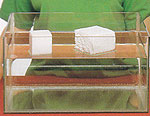 STEP 1
STEP 1
Put the two Styrofoam chunks into a large tank of water. They will float well, because their material is so light. Only a small amount of upthrust is needed.
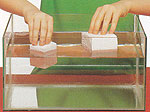 STEP 2
STEP 2
Try pushing the chunks under the water. Now you are pushing lots of water aside. Can you feel upthrust pushing back? The bigger chunk will experience more upthrust.
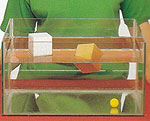 STEP 3
STEP 3
A wooden block floats deeper in the water, because wood is more dense than Styrofoam. A marble sinks, because the upthrust on it is not as great as its weight.
HOLLOW HULLS
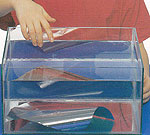 STEP 1
STEP 1
Put a piece of foil about 8in by 6in into a tank of water. With just the slightest push, it will sink. This is because it does not displace much water, so there is very little upthrust.
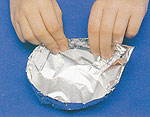 STEP 2
STEP 2
Lift the sheet of foil out of the water, and dry it carefully with a paper towel. Now mold it into a simple boat shape with your fingers. Take care not to tear the foil.
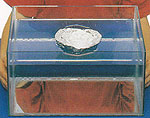 STEP 3
STEP 3
Put your foil boat into the water. It should now float. It will not sink so easily. Its shape pushes aside much more water than it did when it was flat, so the upthrust is greater.
Back to School Projects Main







